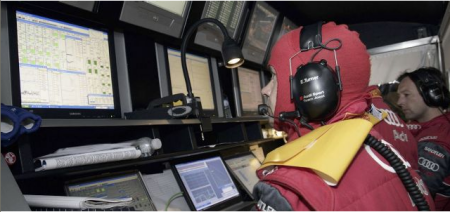Numbers are an aspect of reports. If you don’t understand the background, however, they fall short of their purpose. For Audi and Peugeot, it’s the same story tomorrow in Le Mans.
Bella and I recently raised a few eyebrows about how the German magazine SportAuto uses numbers and charts. Today, though, I have to make a compliment. Their June issue brought a smile to my face and reminded me of an age-old truism among controllers. Numbers are good. But sometimes, none are better. That is, of course, when they don’t explain differences, lead us down the wrong track or are just too boring. It’s natural to believe the numbers we see. Their pseudo-precision is just too tempting. We need to use this effect, however, in the proper dosage. For example, as responsible report authors, we might omit these numbers totally – or at least not focus on them or use them as the basis for discussion.

Before you can understand the performance numbers in Le Mans tomorrow, you need to understand the background in detail. Surprisingly, knowing the numbers is less helpful than you might think. Image: Audi AG
Marcus Schurig from SportAuto recently did an excellent job of doing just that (Issue 6/2008, p. 114–121). He summarized the information that you should know for tomorrow. If you didn’t know, tomorrow on Saturday, June 14, 2008, the legendary 24-hour motor race in Le Mans will start at 3 PM. Unlike the European Cup in soccer, here you have to be a die-hard fan in order to enjoy this drawn-out race on a circular track.
It was as if a light bulb had gone off in my head. Numbers alone really don’t help. In fact, just the opposite holds true. Audi and Peugeot are the two candidates with the best chances of winning. The data that I got from a different magazine called Auto Motor Sport show that both the Audi R10 and Peugeot 908 have 12-cylinder motors. Both are two meters wide and 1 meter high, have an 81 liter gas tank, weigh 900 kg and have a similar strength with 650 – 700 horsepower and 1100 – 1200 Nm torque. Both have 5500 ccm cylinder capacity. Both work with the same 2.94 bar turbo-charger pressure, the maximally allowed amount.
Yet they are very different. The Audi is open. The Peugeot is closed. For the Peugeot, everything is subordinate to road performance. Its closed cockpit is better designed regarding aerodynamics. Its flat constructed motor has a very low center of gravity. Audi’s open cockpit, however, keeps the pilot cooler. There are no problems with door safety or the efficiency of the windshield wipers. Switching drivers is much simpler and, therefore, faster. Peugeot, on the other hand, works with a chassis that can be tuned to softer suspension levels. That doesn’t just improve traction and reduce wear and tear on the tires; the pilot can also drive harder over the curbs. Then again, repairs on the Peugeot are more complicated. The Audi, however, is more reliable.
Marcus Schurig opted against using tables and charts. Instead, he cleverly summarized everything that could explain the success of the various concepts. He remains focused on the most important aspects of analysis. He uncovers and compares the variables that play an important role. He makes hypotheses on causes and effects. And he is as resourceful as you have to be when you are missing important information. After all, neither Audi nor Peugeot are very talkative when it comes to their concepts and strategies.
What can we as report authors learn from this example? Numbers and pilots in Le Mans have one thing in common: they only reveal their potential in the right context.
